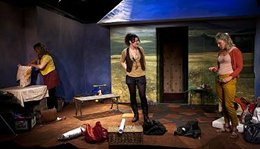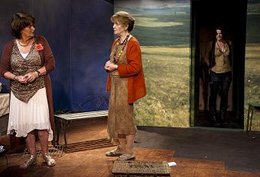With his new play, The Hen Night Epiphany, playwright Jimmy Murphy set outs to deconstruct the complexities of the female bond. When bride-to-be Una drags her two friends, her future mother-in-law and her fiancé’s godmother to her newly purchased run-down shack (“only 80 minutes from Dublin”) for her hen night, an evening of bickering and revelation is on the cards. That the play’s programme describes it as being “in the raucous vein of the recent movie Bridesmaids” might send many potential theatre-goers running in the opposite direction – but far from being a frivolous staging of prenuptial howls and giggles, Murphy’s script rests on this all-female dynamic to act as a vehicle to tackle some of life’s big issues.
I’m giving no secrets away by saying that The Hen Night Epiphany’s central theme is domestic abuse - mainly because that old chestnut about being assaulted by a piece of furniture to explain a nasty bruise is trotted out by the main character Una (Lisa Harding) barely five minutes into the performance. Despite this early allusion, she manages to keep her secret under wraps from her friends, and it soon transpires that Una is not the only one with a secret.
 Sonia Haccius’ set allows the cast use it as a proverbial closet in which to hide their respective skeletons. Dominated by a painted landscape scene that provides a backdrop so idyllic that it conjures up memories of The Quiet Man, the greenery is interrupted by a dingy hallway with greying wallpaper that allows the women to disappear off to make tea and fetch sandwiches at alternate times, allowing for secretive whisperings and interrupted conversations. A single bulb dangles from the ceiling of the hallway, lighting various paraphernalia that have been left behind by the house’s previous owners: a barbeque, a mattress, a child’s tricycle. “They fell behind on their mortgage so the bailiffs came one day, threw them out and boarded it up,” explains Una. “Seems what they couldn’t carry they just… left behind.” (This is one of the many references to the faltering housing market.) Director Joe Devlin makes use, too, of the space beyond the audience’s seats as he sends characters traipsing off-set to find booze; and when a group of women get together with a crate-load of booze, the chances are some home truths are going to be told.
Sonia Haccius’ set allows the cast use it as a proverbial closet in which to hide their respective skeletons. Dominated by a painted landscape scene that provides a backdrop so idyllic that it conjures up memories of The Quiet Man, the greenery is interrupted by a dingy hallway with greying wallpaper that allows the women to disappear off to make tea and fetch sandwiches at alternate times, allowing for secretive whisperings and interrupted conversations. A single bulb dangles from the ceiling of the hallway, lighting various paraphernalia that have been left behind by the house’s previous owners: a barbeque, a mattress, a child’s tricycle. “They fell behind on their mortgage so the bailiffs came one day, threw them out and boarded it up,” explains Una. “Seems what they couldn’t carry they just… left behind.” (This is one of the many references to the faltering housing market.) Director Joe Devlin makes use, too, of the space beyond the audience’s seats as he sends characters traipsing off-set to find booze; and when a group of women get together with a crate-load of booze, the chances are some home truths are going to be told.
It’s not difficult to guess the vein of these home truths as they apply to each woman because, although the issues are serious, some of the characters are quite sterotyped. For someone tasked with harbouring a secret such as Kelly's (Sinéad Hackett), it is slightly disappointing that her character is so outwardly sluttish in both dress and the giggle that follows every innuendo-laden sentence. Toned down a notch, Kelly might have served as a reference to the tribulations and stigma facing a modern woman embracing her sexuality. Here she seems to exist solely as a warning to other women that if you behave in a certain way, you should expect certain consequences.
The characters of Una and Triona (Deborah Wiseman) are slightly less formulaic, but it does seem as though each has been constructed to convey a message: Una’s inoffensive pastel-coloured clothing and outwardly sunny demeanour warn of the dangers of being a pushover in an abusive relationship, and Triona’s constant talk of marriage and the way that she incessantly sends text messages to her boyfriend throughout the evening seem to act as a caution against being too demanding. Jimmy Murphy has considered muliebrity, vulnerability and doggedness in the creation of his characters, and in doing so he has captured characteristics that are inherent in most women. However, in carving up and assigning these characteristics individually, he has rendered each of the three younger women slightly one dimensional.
 More well-rounded portrayals are seen in the older characters of Olive (Anne Kent) and Anta (Margaret Twoomey). Perhaps the most well thought out and striking of scenes occurs just before the interval, when a heated exchange between the two demonstrates that memories from the past can still be as vivid as if they happened only yesterday. This scene also gets to the real crux of the play: not the overtly obvious subjects of abuse, promiscuity or relationship troubles, but the deep-rooted issues of loyalty, betrayal and acceptance. Against the backdrop of a dimming evening in a nameless commuter town, a mother and a godmother try to come to terms with what they don’t want to accept and what they know deep down to be true.
More well-rounded portrayals are seen in the older characters of Olive (Anne Kent) and Anta (Margaret Twoomey). Perhaps the most well thought out and striking of scenes occurs just before the interval, when a heated exchange between the two demonstrates that memories from the past can still be as vivid as if they happened only yesterday. This scene also gets to the real crux of the play: not the overtly obvious subjects of abuse, promiscuity or relationship troubles, but the deep-rooted issues of loyalty, betrayal and acceptance. Against the backdrop of a dimming evening in a nameless commuter town, a mother and a godmother try to come to terms with what they don’t want to accept and what they know deep down to be true.
The Hen Night Epiphany is a brave venture by Jimmy Murphy into the female psyche and, despite a few clichés, sometimes he hits the nail on the head. When the unnecessary references to the housing market and the bailiffs are removed, what remains is an arresting look at the way women respond to crisis, and how they respond to one another.
Sheena Madden works with RTÉ Radio and writes on theatre and music for a number of publications. She recently completed a BA in Journalism.